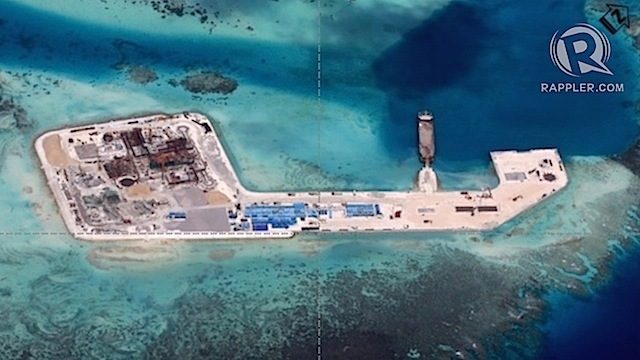SUMMARY
This is AI generated summarization, which may have errors. For context, always refer to the full article.

MANILA, Philippines – China’s reclamation activities in the disputed West Philippine Sea (South China Sea) are likely to endanger the Philippines’ fisheries sector and food security for the entire region, and could result in up to P4.8 billion in lost economic benefits.
This was the conclusion reached by the Bureau of Fisheries and Aquatic Resources (BFAR) after analyzing the ecological impact of the reclamation.
The reclamation in 5 reefs in the Spratly Islands in the West Philippine Sea has buried 311 hectares of coral reefs – 5 times the size of Rizal Park in Manila (58 hectares), according to the BFAR.
This is higher than the initial estimate given by the Philippine Department of Foreign Affairs last April 13, which pegged the damaged reefs at around 121 hectares.
Breakdown of reclaimed area in Spratly Islands, West Philippine Sea (data from BFAR):
| REEF | ESTIMATED RECLAIMED LAND AREA (in Hectares) |
| Gaven Reef | 14 |
| Union Reef North | 7.5 |
| Union Reef South | 12.5 |
| Cuateron Reef | 12 |
| Fiery Cross Reef | 265 |
| Total Reclaimed Area | 311 hectares |
BFAR Director Asis Perez said the 311 hectares is a “conservative” estimate since it does not yet include the reclamation observed in Mischief Reef.
The West Philippine Sea accounts for 26% of the country’s fishing grounds, said Perez. Around 12,200 fishermen from Pangasinan, Zambales, Bataan, and Palawan are known to fish there.
“We have a lot of fisheries resources there. We have skip jack tuna, yellowfin tuna, big-eyed tuna, galunggong, lapu-lapu, maya-maya,” said Perez in a press conference hosted by the BFAR on Thursday, April 23.
Edgardo Gomez, a National Scientist and professor emeritus at the University of the Philippines Marine Science Institute (UP MSI), said the economic value of each hectare of coral reef is $352,249 (P15.6 million) per year.
This figure accounts for the coral reef’s ability to provide food (valued at $677 per hectare per year), raw materials, waste treatment, erosion prevention, and tourism, among other services.
Thus, the total economic benefit of all 311 hectares of coral reefs lost to China’s reclamation is $109.5 million (around P4.8 billion). (READ: China reclamation may cut PH access to West PH Sea)
It’s a lost opportunity for science as well. “My fear is that there are undiscovered species that are gone forever without us ever having the chance to study them,” said Gomez.
Marine biodiversity hot spot
Not many people fully appreciate the significance of the West Philippine Sea to global marine biodiversity, Gomez said.
“Studies have shown that, in the West Philippine Sea, there are also 500 species of hard corals. This is similar to the most specious part of the world and needs protection,” Gomez said.
He said the coral reefs in the West Philippine Sea also help prop up biodiversity in nearby seas and in other parts of the Triangle.
“This is the source of much marine life. The larvae [of marine species in the West Philippine Sea] goes to the Sulu Sea and Sulawesi Sea, then moves to the west,” he said.

He cited a 2011 study that found that healthy coral reefs in the West Philippine Sea are vital to ensuring the productivity of neighboring seas because it is the spawning ground and nursery of marine species that travel to these smaller seas.
Reclamation effectively wipes out colonies of coral reefs as the reefs are buried under sand and soil. “It could take millenia to restore those coral reefs,” said Gomez. (READ: Philippines to UN: China reclamation destroys nature)
Fishermen who depend on the bounty of these seas may, in the long-term, observe less fish catch.
‘Wiped out’
Poaching is another activity worrying the government, scientists, and environmentalists, as Chinese poachers have been known to steal endangered marine species from the West Philippine Sea.
Thousands of giant clams are reportedly taken by Chinese vessels to be made into sculptures and home accessories.
Gomez said the hundreds of giant clams that he helped plant in the Spratlys since the 1990s have been wiped out.
Conflicting claims by various countries is hindering the declaration of the area as protected, but there are some initiatives to include parts of it in the Coral Triangle through a regional declaration, said Gomez.
But because of China’s aggression, there is no telling whether such efforts will bear fruit.
Harassed Filipino fishermen
There have also been recent reports of Filipino fishermen being harassed by Chinese fishing vessels.
Perez said that on April 13 and 16, Philippine fishing vessels were cornered by boats which appeared to be under Chinese jurisdiction.
In the April 16 incident, 20 Philippine commercial fishing boats on a fishing expedition in the West Philippine Sea were accosted. Their fish catch was taken from them, and their equipment and fuel thrown away.
Perez said these were just initial reports transmitted by radio from BFAR regional offices. (READ: PH Coast Guard confirms Filipino fishermen harassed by China)
He expects to receive more information on Friday, April 24, when the fishermen arrive on Philippine shores.
To ensure Filipino fishermen’s safety, Perez said his bureau’s strategy is to keep them away from the West Philippine Sea.
“We don’t want our fishermen to be in the danger area. Because if we allow them to be accompanied, you are putting them in danger,” he told media.
But Perez said his agency is ramping up monitoring, not only in the West Philippine Sea but all Philippine seas.
Some 700 ocean guards are currently being trained while 57 patrol boats of various sizes have been delivered. Perez said that for 2015 alone, the agency plans to purchase more than 100 new patrol boats.
Though he refused to give a specific number, he said some of these boats will be deployed in the West Philippine Sea. – Rappler.com
Add a comment
How does this make you feel?





There are no comments yet. Add your comment to start the conversation.